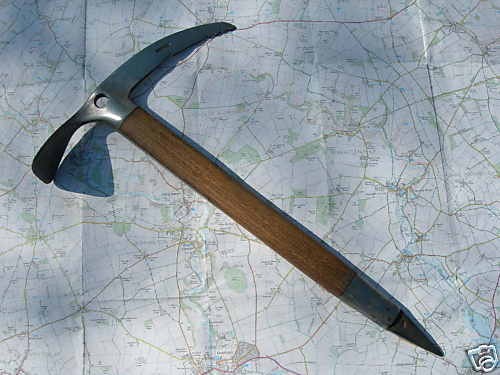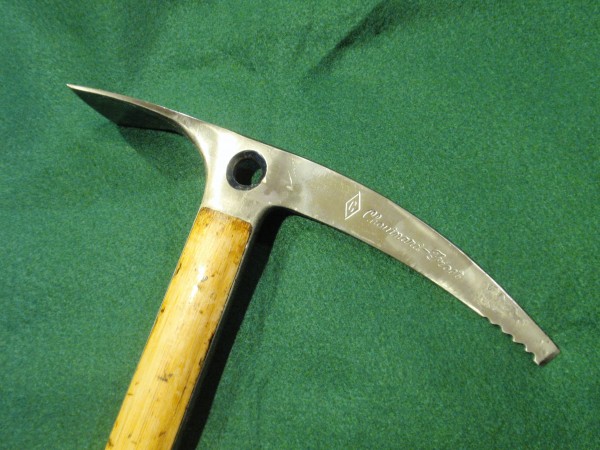"Perfection is achieved, not when there is nothing more to add, but when there is nothing left to take away."
Antoine de Saint-Exupery
French writer (1900 - 1944)
A bit about crampons first:
"The whirlwind Oscar Eckenstein (1859 - 1921) broke into this rather quiet environment in the early 20th century.. An engineer, brilliant mountaineer, argumentative and a loner, he published two articles in the Ostereich Alpenzeitung, on the 20th. July 1908 and the 5th. June 1909, detailing the results of his research on the manufacture of crampons, their systematic use and the incredible feats they could perform. In fig.9 illustrates his designs. Eckenstein’s real innovation and its importance doesn’t just lie in the technical perfection of the crampons but rather in the spirit of courage and innovation with which he defined their use..... his major contribution has been that of a moral nature. This ultimately consists in the faith that mountaineers laid in his inventions: nobody dared before him, but afterwards everybody trusted crampons. (Manual d’Alpinisme du C.A.F. 1934)
Our hero bought his plans to the blacksmith at Courmayeur, Henry Grivel – who, even though he was doubtful, made the crampons for the “English gentleman”, who had the undoubtedly had the advantage of being able to pay. Success was immediate, so much so that on the 30th. of June 1912 a competition for “cramponneurs”, between guides and porters, was organized on the Brenva glacier."
More here:
http://www.alpinist.com/doc/web12f/wfeature-eckenstein
But prior to a discussion on the classic piolet, its partner the crampon deserves credit. The design efforts really should have no differences. Less can be more.
Previous Bruno Schull made a compelling case for the classic axe here:
http://coldthistle.blogspot.com/2011/12/case-for-classic-axe-by-bruno-schull.html
Some great info on the true "classic ice axe" here:
http://elpioletdemadera.blogspot.com/2010/03/blog-post.htmlr
There is more than one classic Piolet!
photo courtesy of elpioletdemadera.blogspot.com/
These days the majority of my own efforts involve a pair of Nomics. But I am fully aware a classic axe is a better tool for moderate mountaineering. Often just the kind of climbs I really like to do.
What follows is a historical account (and hopefully a living history) on the production models of the now classic Chouinard Piolet.
On to the topic of this story.
By several accounts 1970 was the "magic" year. Terros (Peck/MacInnes' Terrodactyl) and the Piolet (Chouinard's Piolet) were introduced to the public. But that may not be totally accurate. The "magic years" came slowly over the prior 40 or so from 1970. Chouinard rightly gives them credit in his "Climbing Ice" tome.
Forgive me if I ponder and then question a Californian writing about the history of alpine ice climbing now..... let alone in the 60s and 70's.
Yvon Chouinard tells of having the Charlet factory make him a 55cm curved pick axe at some point during the Fall/Winter of 1966. His (YC) and Tom Frost's alpine hammer and rigid crampons were introduced commercially in '67 according to the catalog and the Piolet in '69. So my guess is it took awhile for the Charlet factory to come around. Might be a reason Interalp made the Chouinard Piolet for GPIW. (Great Pacific Iron Works) . Bet there is an interesting story there.
Doug Robinson sez:
" the catalog date of introduction of the Piolet is listed as 1969. And by October of that year Yvon delivered to me on the edge of the Palisade Glacier the hickory-handled 70 cm one (and that hand-forged Alpine Hammer) that we put to good use on the V-Notch the next day.......He was very intent on letting me know in no uncertain terms about Scottish primogeniture of the droop. Others listening agreed. May have even said that YC had come through Scotland to take in their development. "
Robinson's recollection was even Chouinard gave credit of his "curve" to the Scots. And that actual production started in '69 on the Piolet. The thought process months prior to the summer of '66.
The Chouinard Piolet became commercially available in the fall of '69 at least in limited quantities and was gone forever world wide by late fall of 1978.
From the beginning of production the Piolet had a classic curve on the blade and a single set of teeth at the blade's tip. The 1972 and 1973 catalog/supplement shows teeth only at the tip.
The spring 1974 Great Pacific Ironworks new catalog shows a new set of teeth by the shaft as well as the original set at the tip. The 1974 news catalog tells us the extra set of teeth have been added on the pick next to the shaft for climbing waterfalls. This is restated in the 1975 catalog.
Bit more trivia for you ;)
"Chouinard and Frost first used hickory wood handles on their tools, but changed to laminated Bamboo in 1972 as it was believed to be lighter, stronger and provided a warmer, better grip than other materials. It was soon superseded by other materials, but the beauty of those early ice axes and tools have endured."
"The Rexilon shaft on Chouinard ice axes was made of a laminate of beech ("faggio" in Italian). It was originally used for pole-vaulting poles in the days before fiberglass composites. CAMP used this before bamboo but both were available for a while."
I remember seeing the Piolet in ash (Euro only), hickory, bamboo and Rexilon. By '78/'79 the wood and laminate shafts were no longer imported into the USA. You couldn't buy a wood handled Chouinard piolet in Chamonix by the fall of '78. The hand forged head was now being attached to a synthetic shaft. Although I have seen all of the wood handle materials never seen a ash tool available in the USA. Although I had a later dbl toothed piolet with a hickory handle that I bought in England.
So what is the deal with the axes only marked CHOUINARD and not CHOUINARD-FROST? At closer inspection it is obvious that the Chouinard-Frost stamp is a two part stamp. Can anyone tell me why the tools were marked with one or both names?
"Frost left the partnership in '75 and shortly after that all the axes were marked CHOUINARD only. '78 catalog clearly shows the new logo on the newest synthetic shafted piolet and the Zero."
Doug Robinson again:
"I think the very earliest Piolets were stamped only CHOUINARD. Then FROST was added. Rumor around the Diamond-C shop was that it was at the insistence of Tom's then-wife, Dorene. That could account for the double stamp, btw. The modest Frost would never have suggested such a thing himself. I always thought it was particularly ironic for his name to show up only on the axes, because of all the hardware that went out of there the axe was mostly YCs design, with the least input from Frost. No question, of course, that the later 70s Piolets, after YC bought out Tom, were stamped only CHOUINARD.
The famous "Diamond-C" mark was on everything else. That too seemed at times ironic. Like on the Stoppers, which Frost and I designed together (and I got to name), with very little input from Yvon, who was partial to Hexes."
I have a couple of old 55s. One in hickory that is a later production axe by the dbl set of teeth in the pick and 3 rivets in the shaft. My earlier 55cm bamboo piolet has one set of teeth and 2 rivets in the shaft and only the Chouinard logo.
Obvious the stamp on all my tools is a two part CHOUINARD...FROST stamping with close inspection. If the production started and ended with a "CHOUINARD" only stamp, it would more easily fit what I see on the tools I have.
The first fiberglass/aluminum shafted tools?
Doug Robinson again:
"Chouinard himself was very active in making the first fiberglass shafts for the Piolet. Driven to it I assume just by breakage. The glass was laid up on an aluminum blank that gave the shape. He was very proud of the used pizza oven he had just installed in the shop to cook the resin. I could see that he liked the technical challenge of getting it all to work. I was writing for a new magazine, a start up called Outside, and did a review."
The first of those axes (fiberglass/aluminum shafts) had hand forged and finished heads from Premanas on the GPIW fiberglass/aluminum shafts.
I was buying what ever Chouinard came out with new for ice climbing. I had wrongfully assumed each new version would offer some advantage and increase either my abilities or safety on ice.
The early fiberglass Zeros in the '78 catalog (that might well have been bamboo painted) turned out to be some what lacking on hard Canadian water fall ice compared to the original bamboo model.
Less than a season into using the new carbon versions I was begging to re-buy my old set of shorter bamboo 50cm Zeros. They also had a shorter spike and came in 50s instead of the 55. It made a difference as did the balance. Most importantly the bamboo versions placed with less effort imo.
from Don Lauria:
"Once when conversing with Yvon I asked what he recommended as the ideal shaft length for an ice axe. His answer of 50-60 cm seemed a little short to me so I asked, Why so short? His answer, If 55cm doesn't reach the snow then the slope doesn't warrant using an axe."
Dates of Production?
If you follow the past catalogs for a historical reference to date gear, you'll find that sometimes Chouinard and the later GPIW catalogs were not as up to date as one might have hoped. It could be a long time long time before actual delivery to the retailers. In the '70s it was common in the climbing/outdoor community to use their catalog's advertising for a new product prior to a public release. And soem times it was never released in that form or in very small numbers! Chouinard became notorious about that sort of thing.
Much of this info came from public conversations on Supertopo. There is a true wealth of historical info. More here:
http://www.supertopo.com/climbers-forum/382806/Classic-Ice-Primer-Chouinard-Catalog-1968
http://www.supertopo.com/climbing/thread.php?topic_id=762638
http://www.supertopo.com/climbers-forum/1191047/Assistance-Needed-Identifying-Old-Chouinard-Frost-Piolet
A short photo essay of the Chouinard-Frost axe:
This is a mid production laminated bamboo model. Two rivets head to handle, single set of teeth and the double stamp of "Chouinard Frost". Between 1970 and Spring 1975 time frame. I bought my first shown lower in the photos in 1973. I suspect this one to be of a similar vintage.
The set of pictures below are of a 2nd gen (two sets of teeth and 3 rivets in the head/handle and a hickory shaft. By the single stamp of "Chouinard" we know it was one of the last production runs. After Frost left GPIW in '75. So this one was made between Summer of '75 and summer of '78.
The bottom axe below was one of the last bamboo tools to come from Camp. Head is the same as a Chouinard Zero but other than the Camp markings unmarked. I bought it in the sell bin at Snell's, Chamonix in Sept of 1978.
2nd gen Zero below with the "new" fiberglass shaft with a forged Camp head, Chouinard designed Zero
Don Lauria photo
1st American production shaft with a machine cut and welded head, 1980
Likely the head was cut and welded by SMC in the PNW.
This axe was offered by SMC within months (1980) of Chouinard/GPIW showing it in their catalog with a fiberglass/aluminum handle. It is also a current SMC Himalayan and no question in my mind, the carbon/fiberglass Chouinard Zero in a past life. Look closer at what follows.
1980 GPIW catalog description of the Zero
The 1980 Zero axe, machine cut and welded with a aluminum/fiberglass shaft.
This one has an aluminum ferrule and spike. Not a plastic ferrule as listed. The standard Piolet had a aluminum ferrule as well. Adze on both is flat as a pancake, not cupped as suggested. The drop on the pick is the same exact angle as the original 1973 versions. There is no more curve on any Zero (wood or composite shaft) with a fixed pick than the original standard axes.
and yet another vesrion of the Chouinard Zero from the same time frame
Bottom axe is a Piolet bamboo clone cut as a Zero. The other two are bamboo as well, one new and the other well used.
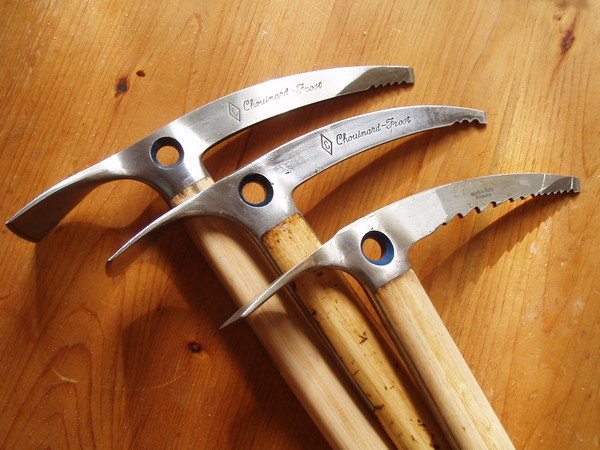
The '78 catalog shows what I believe are painted bamboo Zeros as carbon fiber and the first carbon fiber piolets with Interalp hand forged heads. But again the ferrules are different than the bamboo production models in that '78 catalog. So I could easily be mistaken on the "paint job".
Europe got ash, hickory, Rexilon and bamboo Chouinard tools. The Chouinard-Frost logo changed to Chouinard sometime shortly after '75 and Frost leaving GPIW. Long before '78 if the catalog typical publish date and when the gear was available was any indication. Catalogs were always months if not years behind current production and availability.
Rexilon is not laminated ash or hickory from my understanding.
Rexilon is not a synthetic but a simple wood laminate. Grivel also used Rexilon for some of their early technical axes from the same time frame, mid '70s. '75 perchance? Below is a mid '70s Rexilon axe.
FWIW I asked the Grivel factory to date this axe's production and were unable past "the mid '70s". Looks a lot like the Chouinard Zero from late '77/'78. Makes one wonder which came first. The short (50/45cm) steeply curved axes were all the rage with the European/English ice climbers in Chamonix by 1977/78. Snowdon Moldings, Charlet Moser, Grivel and Simond all offered a version. If any one has a short Grivel or any of the early short wood versions similar to what is pictured I would be interested in purchasing it.
Simond's Chacal would change ice tools again for ever shortly. More on that below.
The last Chouinard "copy"?
Interalp/Camp did make a McKinley axe that was similar to the Chouinard Piolet for REI as early as 1980. Close examination shows there are a lot of differences. They had a positive clearance pick, a slightly curved/cupped adze and a ash or Rexilon shaft. 1980 REI catalog shows ash shafted axes. Same big profile Chouinard spike though.

REI McKinley
Rexilon shafted REI McKinley
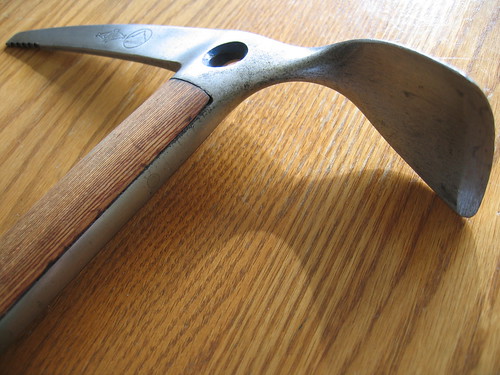
I have kept my original bamboo and a early, 2 rivet handle duplicate that is in like new, and unused condition. I just never liked the thicker bladed dbl tooth tools. Then or now. Totally different feel and look for me from the earliest Piolets. That and the fact that most every late axe I have seen has a slightly bent pick from the hand forging. Looking at the pick straight on almost all bend slightly to the right. ( right hand forgers) The thicker bladed dbl tooth picks even more so.
New, '73 vintage
Old, with well worn and rewelded/hammer forged teeth and pick end
Fun that so many of us used these tools as our first technical tool. I had a 75cm Stubia previous that was unsuitable for steep water ice. And of course long enough to be less handy. I climbed my first frozen water ice with the Chouinard Piolet pictured in 1973.
A few years later I appreciated the added security and ease of placement on water ice with a Zero axe mated with a Terrodactyl. Later yet I used a Zero axe and a Chacal for pure water ice routes till the spring of '82. The thing I find the most amazing is the wooden handled Piolets were only available for a very short amount of time, between late 1969 and summer of 1978. Under 9 years all told.
I cracked the shaft on my original bamboo piolet on a Canadian waterfall back in winter of '76/'77 and then relegated it to guiding for the next decade until I just couldn't justify it any more by late '80s.
Buy the '74/'75 winter season I was using a multitude of new and never ending stream of ice tools. Each and every one modified in some manner to heighten their performance. The search for the one "best" ice tool still continues.
Crack is the small black line bottom right of the tang.
| | |  |
|
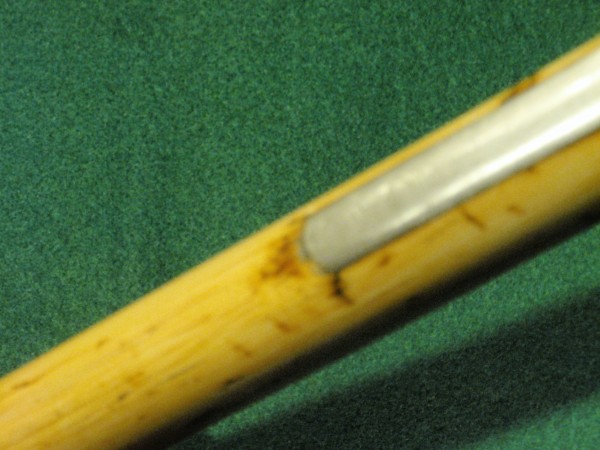
The classic Chouinard Piolet spike
2nd gen Rexilon Piolet
| |
| | | |
By the mid '80s only the older guides would know what my tool was. And clients were questioning my choice of equipment, "climbing with a "wooden" axe" ;-) I was able to rewelded the tip several times early on to keep the axe working i the field. I did a terrible job last year bringing it back to "new". Just haven't gotten around to redoing it yet. Way more work than I remember.
Teh questions behind :
www.bradleyalpinist.com
I think much of the important info on the Chouinard Piolet from the Bradley web site is misinformed at best. Let me detail why I think that. I would also be pleased if anyone can dispute my comments and would offer first hand evidence of more accurate details. I am only looking to document the truth, nothing more.
My comments are highlighted.
from:
http://www.bradleyalpinist.com/cart/index.php?main_page=index&cPath=28
RE: Chouinard-Frost Piolet
"Somewhere long about 1969, Yvon Chouinard and Tom Frost, of Chouinard Equipment in Ventura, California, commissioned the Codega brothers to build an axe to their specifications. This axe, called the Chouinard-Frost Piolet, featured a hand forged, ground and polished chrome-nickle steel head and a hickory shaft, and has since been a mountaineering equipment classic in the both the US and in the Alps. By printing time of Chouinard Equipment's first catalog in 1972, the Chouinard Piolet shown on page 34 had a new laminated bamboo shaft design, dubbed to be lighter weight and just as strong as the hickory shafted original.
Over the next 7 years, the Chouinard Piolet went through a few other design changes, including a revised marking on the head, omitting "Frost" from "Chouinard-Frost". This change was first seen in the 1978 catalog, even though Tom Frost had left the company years earlier, in 1975."
Chouinard catalogs were long known to retailers for being late to the retail market with many items discontinued or unavailable by the time the catalog made it to print and to the dealers. By 1978 the wooden handle Chouinard axes of any type were no longer available in Europe or by then easily available in the USA. And by the fall of '78 even Snell's in Chamonix had the Camp bamboo Chouinard clones on sale, what few they did have. Mind you these were "newest" three rivet, dbl tooth heads but with no Chouinard marking. In 1978 The last of the US imported axes had a 3 rivet head, dbl teeth and only Chouinard stamped on them.
The 1978 Great Pacific Iron Works catalog (formerly Chouinard Co. their 3rd catalog) is a interesting mix of the newest carbon fiber Piolet with a hand forged head and "fake" carbon fiber Zeros with bamboo shafts painted to resemble carbon fiber. Clearly a transition time for Chouinard piolets. The Carbon fiber axes were available by the winter of '79. I bought both a carbon fiber piolet and a Zero axe that winter. Found the early carbon fiber lacking on hard Canadian ice and went back to a bamboo Zero axe, now then, in '79, extremely hard to find.
Doug Robinson commented on his original Piolet from '69 as being a Rexilon handled version not hickory.
"Other designs of the Piolet included a version with two sections of teeth or notches(double-toothed) on the drooped and curved pick. In other modifications, the shaft material changed again, first to a laminated hickory, then laminated ash for a short time, and eventually a synthetic called Rexilon in 1975, after the UIAA began to raise concerns with the integrity of "wooden" axe shafts. All wooden shafted variations of the Chouinard's Piolet were made by C.A.M.P., but the axe model was phased out of production after 1978."
I've not seen laminated hickory or laminated ash Chouinard Piolets. No record of either in any Chouinard or GPIW printed material. (3 catalogs and one major update flyer) But I trust Doug Robinson's comment on what handle materials were used. The reasoning behind that end of production was the new UIAA guidelines for shaft strength. Imagine my surprise with two of us showing up for the late alpine ice season thinking we'd buy new tools at Snell's! Plan "B" wasn't all that attractive.
My partner bought a Rexilon marked shaft Piolet in either Spokane or Seattle the 1st half of the winter of '75/'76. I like the added weight pf the Rexilon compared to the bamboo piolet.. And I have owned a number of both hickory and bamboo piolets since.
The Codega brothers offered virtually the same ice axe (same head, with bamboo or hickory hafts)in Europe, sans the Chouinard marking (although markings still included "Interalp", "CAMP" and "Made in Premana" which are all also found on the "Chouinard-Frost: and "Chouinard" stamped versions..
"In the early 80's, the REI Coop contracted with with C.A.M.P., having this same axe design originated by Chouinard, stamped with the REI logo. These axes were offered in REI's original Seattle store through the mid 1980's."
Close but I don't think that is accurate. The CAMP McKinley was offered in the '80 catalog and maybe even earlier but while a CAMP axe it was not a clone of the original Chouinard Piolet design.
Slightly off topic but worth repeating after finding the info again.
I mentioned the first Chacal? (widely acknowledged as the first reverse curved blade)
THE very first Chacel was Gordon Smith's and the design didn't become commercially available until '79. Simond gave samples to all the climbers attending the International Resemblance in Chamonix in '79.
From the "Ice Primer" on Super Topo thread linked above:
A
must read btw if this sort of historical trivia interest you.
"In 1978 I got hold of THE prototype Chacal from Luger Simond - He was going to make a straight drooped pick but I held the shaft of the axe while he cut holes in an ordinary curved pick blank reversed. Then he cut teeth and changed the angle of the end of the pick to make a point to penetrate the ice and lo, the first reversed banana pick. Worked brilliantly!!
Gordon Smith"
The "classic axe" today?
There are "walking axes" and there are "ice axes" . The "ice axe" is designed to climb steep ice and cut steps. It gets hard to identify the pretenders here for me some times because of the advertising hype.
Here is a short list and likely not every tool that will fulfill the role as a "classic" axe. It is a multifunctional tool. More than most of the gear we take climbing today. Pays to remember the Chouinard Piolet and it ilk climbed a lot of steep ice bitd. And still can. If your choice in an axe won't, easily, it is more likely a "walking" axe.
"Where there is snow, one can go!"
Only two of the several classic axes from Grivel
Blue Ice...and a new "classic axe"
SMC has obviously been at it a while now
Petzl's offering
It is no accident that the functional design and angles are so similar over the past 40+ years.Virtually the same pick angle and length today as the original Chouinard Piolet.
Remember the rule of steel.
and.....
"Perfection is achieved, not when there is nothing more to add, but when there is nothing left to take away."






















































BS!VkJKpf!~~60_57.jpg)

